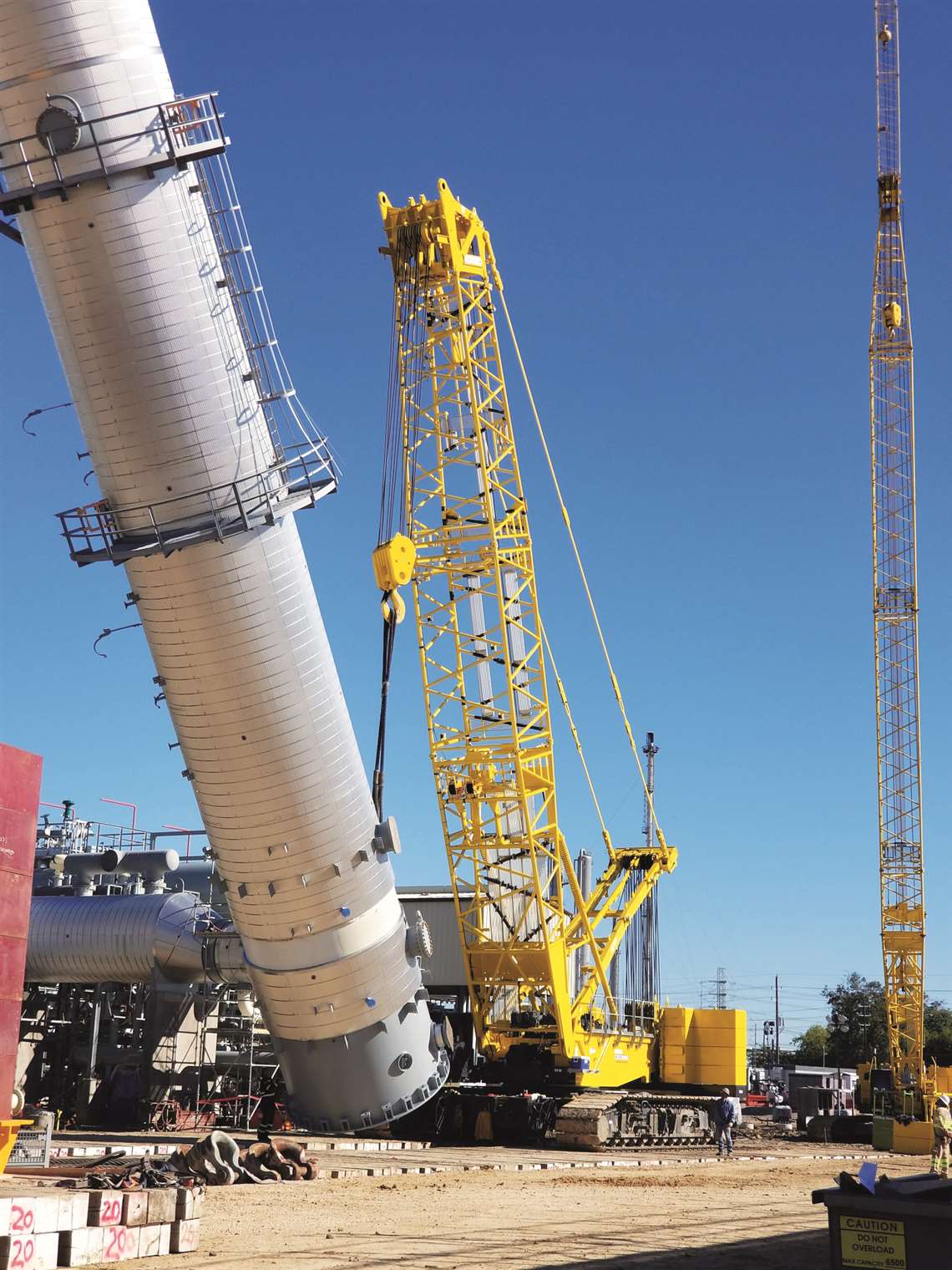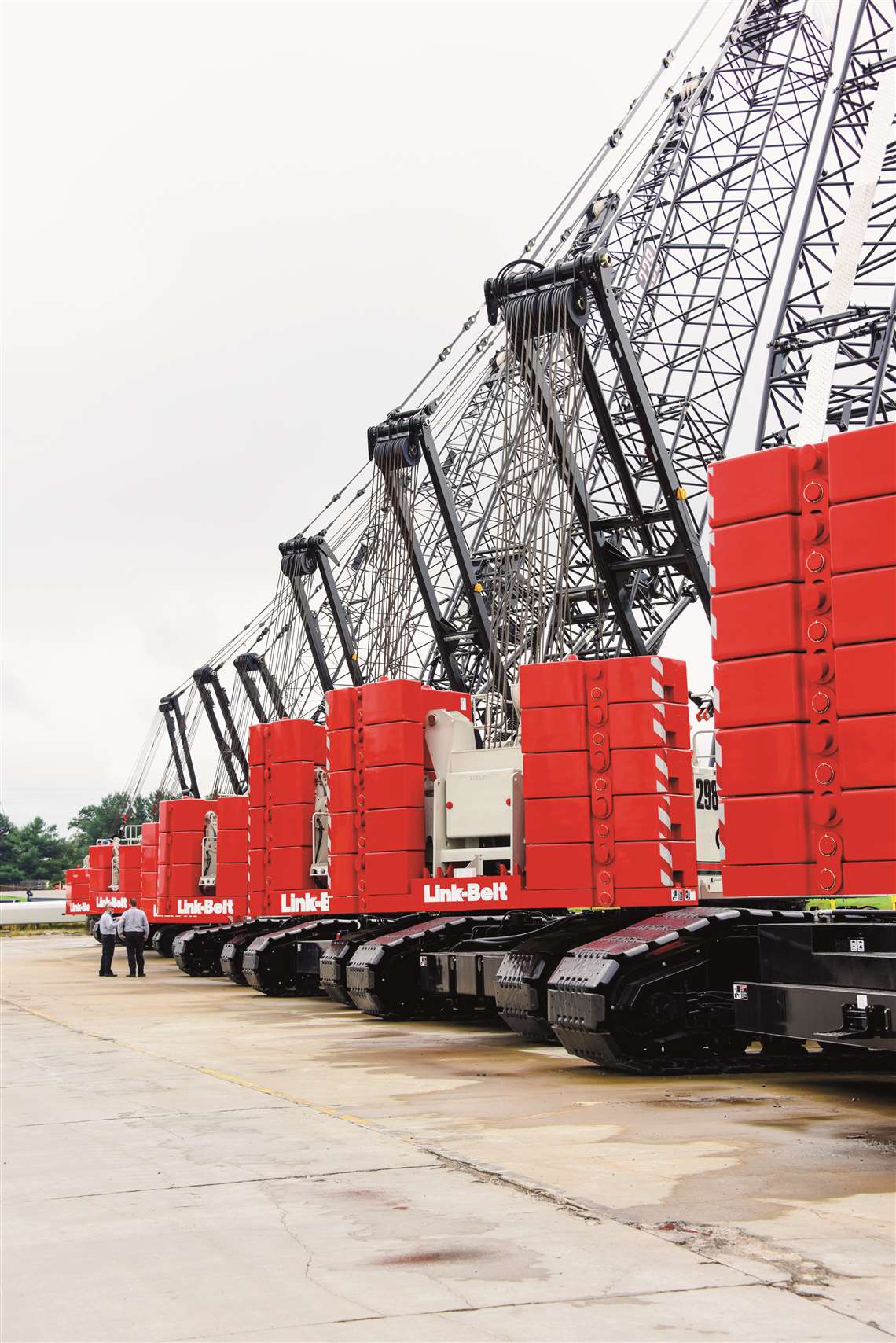Crane industry sees stimulus surge
13 April 2021
As the nation emerges from the pandemic, the finance sector is bullish about crane sales.
Assuming there are no major hiccups in the rollout of the Covid-19 vaccine program, crane and construction equipment sales are expected to pick up as the pandemic winds down. A strong supply of optimism is also apparent, as the economy rebounds, with the help of the $1.9 trillion stimulus package recently passed by Congress and signed into law by President Joe Biden.
 Ample projects and favorable interest rates make now the perfect time to buy a new or used crane and to rent a crane.
Ample projects and favorable interest rates make now the perfect time to buy a new or used crane and to rent a crane.
To put the state of the industry into perspective, American Cranes & Transport convened a forum of finance professionals to discuss trends and issues associated with crane and equipment finance. Our forum of experts includes the team at Harry Fry & Associates (Harry Fry, Cheryl Fry and Tonya Fry), Crestmark’s Jeff Whitcomb and Commercial Credit Group’s Linda Brown.
How do you characterize the market for crane and equipment financing?
Harry Fry & Associates (HFA): We have not experienced much of a slowdown in financing throughout 2020. HFA works with many different funding partners located throughout the U.S., and was able to keep financing available to those companies that requested it. During 2020, HFA included information, in our finance requests, on how Covid may have affected the companies and how the companies responded to any adverse effects of Covid. We continue to discuss Covid affects with our potential clients and have seen that most companies have endured during 2020. We would characterize the market for crane and equipment financing as strong.
Jeff Whitcomb: I am seeing a significant uptick in activity across almost every segment in the crane industry. I see a lot of buyers in energy, civil construction, residential construction, infrastructure and ports, which I do not expect to end any time in the near future. Macro-economic factors contributing to growth include insufficient inventory of new homes; massive investments in high growth companies, logistics, warehouse builds, cloud computing, 5G, etc.; major infrastructure investments in tunnels, highways, bridges, waste-water treatment and airports; and the repurposing of existing buildings with investments in sustainable architecture and city planning.
Linda Brown: Stimulus, stimulus and more stimulus. Although the anticipated infrastructure package has not been passed, states will receive large payouts from the $1.9 trillion stimulus bill. That, combined with past stimulus funds, plus the anticipation of an infrastructure bill, should drive construction spending/financing well into 2023-2024. We characterize the overall construction and crane markets as bullish.
How do you envision the market responding to the end of the pandemic?
Harry Fry & Associates: During 2020, most crane and lift companies were deemed essential services. Work may have slowed down at the very onset in March-April 2020, but picked up to a normal pace once the companies were deemed essential. There have been pockets of the U.S. that have been more adversely affected, such as New York, New Jersey and California, where the state mandates for lockdowns were far stricter. As states release their lockdowns, we are seeing the work in those areas start up again.
Jeff Whitcomb: There is massive pent-up demand. When the pandemic ends there will be nothing “holding the water back.” Travel and leisure markets will likely be the first out of the gate and that will drive demand at ports. I also see the energy sector pricing coming back, which will allow for investment into the sector and therefore, we will see energy services take their equipment out of mothballs. We are all working in new ways and from new locations, and I think many of those changes will be permanent. This will drive a lot of economic activity as supply chains are altered and transportation is used less often.
 While travel has been imited during the pandemic, it is recommended that buyers try to see a crane before they buy it.
While travel has been imited during the pandemic, it is recommended that buyers try to see a crane before they buy it.
Linda Brown: We at Commercial Credit Group (CCG) see the construction finance markets coming back strong in 2021, although it might take until mid-year to gain full momentum. The construction finance market proved to be surprisingly steady through 2020 with the exception of a drastic slowdown during March-April. We are now seeing more activity in the crane markets and anticipate continued growth in both the crane and construction equipment finance markets going forward.
Is there likely to be a surge in crane sales as the pandemic subsides? Will pent-up demand play out?
Harry Fry & Associates: Pent up demand for cranes is tough to gauge as even during the pandemic many companies continued to acquire new and used equipment. Many crane companies are considering crane acquisitions and would purchase used equipment if available. So yes, if the economy opens to full potential, I believe many companies would have a demand for new or used cranes. However, when the economy appears headed for strong growth a perfect storm could hold a “surge” back because demand for manufacturing materials will be strong across many industries, causing a strain for supplies, which in effect may dampen factory deliveries.
Jeff Whitcomb: Yes, I believe there will be. The only limiting factor will be availability. We already see it in some crane models – whether that is a result of engine supply issues, electronics or other. It will take some time for the manufacturing plants to catch up. Perhaps, for the balance of 2021 there will be “fits and starts” in that regard. I do see a long, sustained demand for both new and used cranes that will last for several years. Infrastructure projects are really strong, and I am personally seeing a lot of activity there.
Linda Brown: Yes, we believe there is pent up demand. As mentioned, we surprisingly saw steady growth in the construction equipment markets during 2020 but limited crane activity. Jobs were shut down or delayed causing equipment orders to be cancelled or put on hold. We are now seeing the beginning of a resurgence in crane buying both on the new and used side.
Is now a good time to buy a crane?
Harry Fry & Associates: We believe this is a good time to buy or add to a company’s crane fleet because interest rates are still favorable and overall business is continuing a positive trend for the foreseeable future. The issues we see is used and new crane availability, but if you can locate equipment, finance conditions are quite good.
Jeff Whitcomb: There has never been a better time to buy a new crane. There has also never been a better time to lease or rent a new crane. The price gap between new and used is not as large as it once was; the new cranes are very technologically advanced over their predecessors and are safe as they have ever been. Over the past ten years we saw the OEMs turn to doing what they do best as well as consolidation in the industry. I feel this was a good thing both for build quality and for pricing. More than ever before, the acquisition of a new crane is more closely aligned with the specific project needs and durations. Leasing has once again become a quite popular financing option. When Rouse Analytics merged with Ritchie Bros., it brought a massive improvement to the tools that bank-owned lessors and independents use to set lease residuals. This strength in residual setting in turn helps lower the monthly payments for cranes. It is not uncommon for an end user to be able to save thousands of dollars by terminating a higher month-to-month rental payment and initiating a long-term lease.
Linda Brown: We like to think it’s always a good time to buy a crane. But right now, we think it’s a very good time to buy a crane for one primary reason, low interest rates. Interest rates are at an all-time low and can make a big difference in offsetting some of the costs associated with large ticket items such as a crane purchase. The Fed does not project raising rates anytime soon, but it could potentially begin to happen in 2022 if not before depending on market reactions. So yes, we believe it is a good time to buy a crane, new or used.
What are typical interest rates and terms?
Harry Fry & Associates: Interest rates and terms are very credit-sensitive and collateral- sensitive. It would be difficult to say what would be typical. Terms for new equipment can be as long as ten years, depending on what the collateral is. For older equipment, terms can vary quite a bit. HFA works with many funding partners, allowing us the opportunity to provide flexible terms for most any aged collateral.
Jeff Whitcomb: Interest rates had been quite low and stable until March. We saw a slight uptick in benchmark interest rates, and we expect that trend to continue into the summer. Rates had been in a range, from the 2.5 percent range all the way to the 7.5 percent range, depending on the credit profile. I would not be surprised to see an increase of at least 50 basis points as the economy is hot and inflation pressures are there. The $1.9 trillion stimulus bill that was signed into law on March 11 will also lead to increased pricing pressures.
Linda Brown: There are seldom typical interest rates or typical terms. Each company, each borrower and each transaction are unique. The good news is the lending markets offer many options for many types of borrowers. If you are looking for a new unit, there are some good manufacturer rate plans. Banks are releasing some of the cash reserves they set aside for losses that never materialized during the pandemic. Banks will be looking to put that cash to work. We at CCG continue to work with many types of borrowers on all levels. We work hard to structure deals to each borrowers’ specific needs and set of circumstances.
Do you see more of a tendency for used or new crane/equipment financing?
Harry Fry & Associates: This is something that we keep track of every year. Generally, it seems that our funded transactions are split very evenly between new and used equipment – 55 percent new/45 percent used. In 2019 it was a bit heavier towards new equipment at 62 percent of our transactions. I think we might see a bit more used equipment purchases this year – primarily due to the delays in deliveries of new equipment.
Jeff Whitcomb: Nothing has changed with respect to new versus used. In general, I see the same companies who bought used equipment before buying used equipment now. In certain segments where there are longer lead times for new cranes there is no choice. I still see excellent value in new cranes.
Linda Brown: We do see a demand for new and used cranes alike. There are differences in demand depending on geographics. For example, in California due to CARB issues, we see more new purchases versus used. This results in good used units being sold out of California into neighboring states. In the oil field states such as New Mexico or Texas, you might see more used units being sold so it just depends. We at CCG do not put a preference on new versus used when it comes to financing. Cranes hold good value over a long useful life and are proven to be strong income-producing assets, so we consider a good used crane just as attractive as a new crane when it comes to financing them.
Do you see more optimism in the market?
Harry Fry & Associates: Our clients are optimistic, but cautious. They are seeing the work continue but anytime there is a new administration in place, a cautious approach takes place. If a new infrastructure bill gets passed, we will see a much more positive outlook for the year.
Jeff Whitcomb: I do see more optimism in the market. I live in Southern California and there is a lot of positive change happening here in terms of the economy and the market. It has been a difficult fight to get through Covid, and for everyone who has worked their way through it. However, I think it has strengthened our resolve to do better and to continue to pursue the American dream in a way that is meaningful for all. This can mean subtle changes (like more affordable housing) and this can mean dramatic changes (like completing major projects that make our lives better and safer). This is the magic of our industry. Cranes truly lift the world (both in physical terms and in spirit). I cannot wait to see what the future holds for all of us.
Linda Brown: Yes, we do see more optimism in the market. The construction backlog numbers continue to rise, and a large number of construction companies are looking to hire. Stalled jobs are coming back online, and as mentioned, backlog is building. So yes, we are seeing a lot of movement in the construction markets and our projections are positive going forward.
What else could you say about the equipment finance market?
Harry Fry & Associates: We’d like to mention transactions that are from a private party, not through a bona-fide dealer. When purchasing used equipment from a private party, be sure to do all of the due diligence to ensure that the equipment is free and clear of all liens. This may take extra time to close a transaction but will be necessary to ensure that the lender can have a proper security interest in the collateral being financed. In addition, we urge customers, even if purchasing from a dealer, to try not buy equipment sight unseen. Covid has made travel difficult, but it is worth the time and effort to make sure the unit that is advertised is what the customer expects it be and will be a fit for their fleet of equipment.
Jeff Whitcomb: The equipment leasing and finance industry is more dynamic than ever. I believe the growing FinTech segment is going to dramatically improve the way we consider new applicants, the way we document our deals and the way we serve an ever-larger segment of the economy. Our parent company, Metabank, has a strong focus on financial inclusiveness. My hope is that an ever-growing portion of our country has access to financial services as a direct result of our work.
Linda Brown: Thankfully, the pandemic appears to be under control. The lending markets are strong, offering many options, and the rate environment is positive. We at CCG are optimistic and look forward to an active construction buying market for the next couple of years.
STAY CONNECTED


Receive the information you need when you need it through our world-leading magazines, newsletters and daily briefings.




